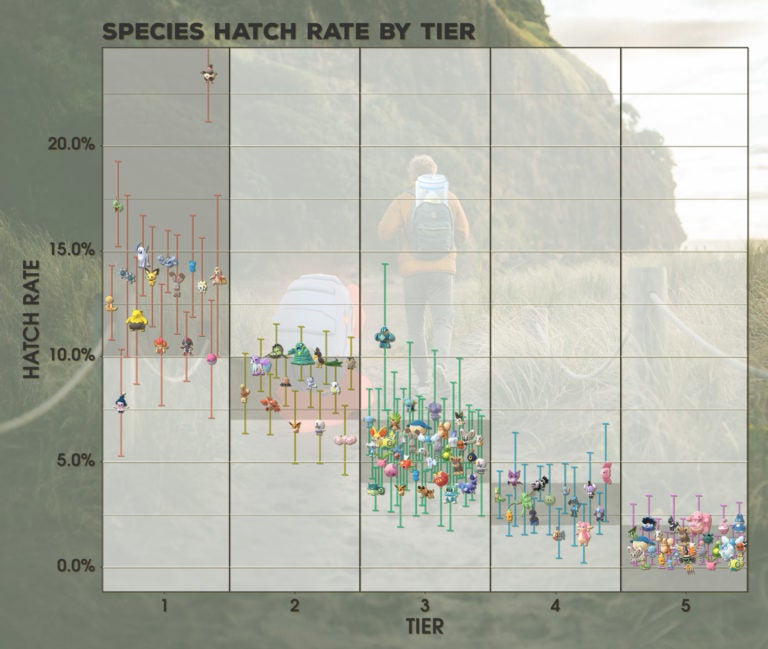This made sorting which eggs to hatch much easier, as it was now clear which were from specific events, and it was also a welcome first step to indicating the likelihood of getting a specific creature, something fans have been loudly calling out for over the past few years. Now, with weeks of data to test, a group of more than 50 hardcore players at top fan community The Silph Road has analysed thousands of egg hatches to see how well the tier system matches up to reality - and there are some surprising findings. The top-line finding here is that Pokémon within a specific rarity tier do not appear to have a fixed chance equal to all others in that tier. In other words, two creatures both listed as Tier 1 rarity could in reality have different chances of hatching. Tiers should therefore be considered a range of hatch rates, as displayed in Silph Road’s chart below. Roughly speaking, a Tier 1 (most common) species will have a greater than 10 percent chance to hatch. Tier 2 looks to be between seven to 10 percent, with Tier 3 at four to seven percent, Tier 4 at two to four percent and Tier 5 (most rare) at two percent or less. The vertical lines on the chart indicate a 95 percent confidence interval for each species - and therefore it’s not possible to rule out some overlap between Tiers. Additionally, the chart clearly shows an outlier even beyond these general ranges. Vullaby, a Tier 1 creature found in 12km eggs, appears to have a greater than 20 percent chance of hatching - apparently more than double some other Tier 1 species in the same egg pool. (Gollet, a Tier 3 creature, also appears adrift from the typical chances of other Pokémon in its category, though Silph Road suggests this is more likely due to a lack of data for it.) Tier 1 in particular appears to have the broadest range of possible hatch rates. Data shows you are around twice as likely to hatch a Larvitar than a Pawniard, for example. As ever, Silph Road research is conducted by fans and relies on crowd-sourced data. That said, it is the only method fans have to peer into how the game works - and it is backed by a lot of hardcore maths: “The mean rate for a Rarity Tier is calculated using the weighted harmonic mean of the individual hatch rates,” Silph Road says. “Each species in a Rarity Tier is assigned a weight W based on the total number of hatches for that species, and a rate R equal to the number of hatches over all hatches in the distance pool. “Using a Pearson’s Chi-Squared goodness-of-fit test, we compared the number of hatches for each species to the number of hatches we would expect if the hatch rates were uniform. The Tier 1 pool of 12km eggs differed significantly from our expectations (χ2(4) = 85.534, p less than 0.001). Pairwise comparisons for each individual species showed that Vullaby was observed significantly more than every other species in the 12km egg pool (Bonferroni-corrected p-value = 0.004 for Larvitar and p-values less than 0.001 for Absol, Scraggy, and Pawniard).” Pokémon Go has never gone into detail on how its Tier system operates, and never stated that all creatures in a specific Tier have the same chance of hatching. But the Tier system certainly suggested this to be the case - so this latest research comes as something of a surprise, and has again stirred up calls for the game to show specific percentage probabilities.
